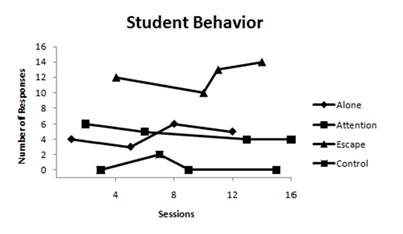


A multielement design is also known as an alternating treatments design, because it measures the effect of multiple treatments delivered one after the other. For instance, two treatments may be compared in order to see which is most efficient in producing the target behavior. The design can also measure whether a treatment is better than no treatment.
These interventions may be administered by alternating on a daily basis, in separate sessions within the same day, or all treatments may be delivered separately within the same session. A functional relationship is demonstrated between the treatment and behavior when different treatments consistently correspond to different levels of behavior, as is seen in the “Escape” condition in the graph above.
There are several advantages of the multielement design. Unlike the reversal design, it does not withdraw treatment and irreversibility is less of a problem. Participants can also receive treatments immediately. It can also be used to evaluate several treatment conditions, as in the graph above.
Start making a multielement design graph!
Information source:
Cooper, J. O., Heron, T. E., & Heward, W. L. (2007). Applied behavioral analysis (2nd edition). Upper Saddle River, NJ: Pearson Education, Inc.